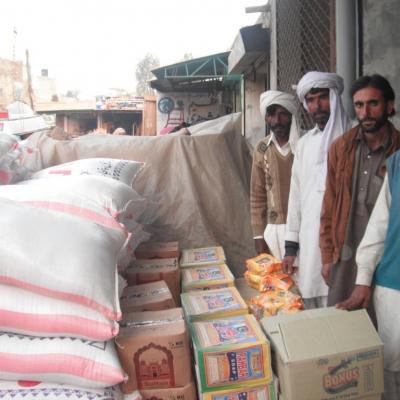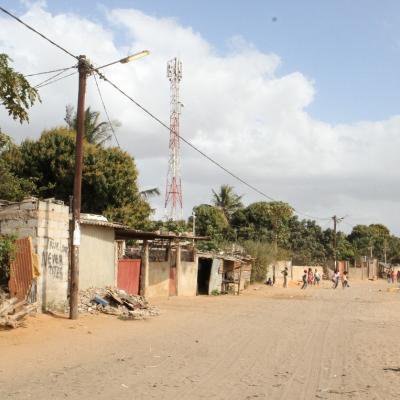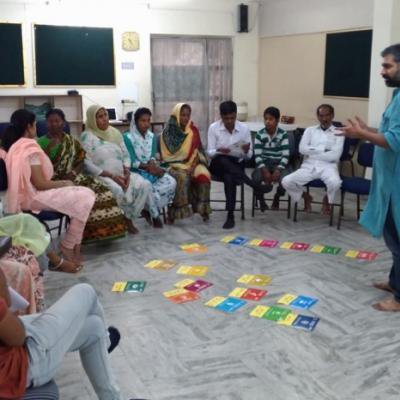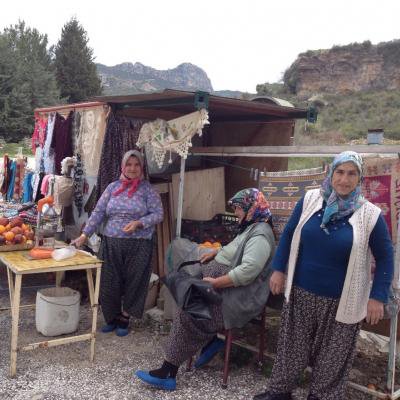Improving the lives of people in developing countries
1 May 2018
The British Academy’s Sustainable Development Programme – part of the UK Government’s £1.5bn Global Challenges Research Fund – has so far funded 16 research teams from across the UK, enabling them to conduct cutting-edge research and generate evidence to inform policies and interventions aimed at improving the lives of people in developing countries. The window for new applications to this programme has just opened, so we thought now would be a great opportunity to look at some of the inspiring and innovative projects funded under the programme to date.
1. The Design of Anti-Poverty Transfers to the Ultra-Poor: Asset Transfers or Cash Transfers?
Professor Imran Rasul, University College London
More than 40 million people live below the national poverty line in Pakistan. Professor Imran Rasul’s project demonstrates how asset transfer programmes have the potential to raise such households out of poverty permanently.

Credit: Professor Imran Rasul
The research team set out to explore whether households would benefit more from asset transfers (such as livestock) or from cash transfers. It found that two years after receiving asset transfers, families tended to have retained them, while those who received cash transfers used that financial injection to buy assets of a similar kind. In all cases, the assets were found to have become central to the families’ labour market activities, allowing increasing numbers of family members to become self-employed and move away from the precarity of insecure, low-paid wage-work.
These results are hugely significant for policy-makers looking for ways of reducing poverty for millions of people in developing countries.
2. Sustainable Energy Access in Mozambique: Socio-Political Factors in Conflict-Laden Urban Areas
Professor Vanesa Castan Broto, University of Sheffield
Mozambique has abundant fossil fuel and hydropower resources and a nascent renewable energy industry. There are also business models, such as the prepaid electricity system, that enable poor people to access energy in urban areas in unprecedented numbers. What, then, explains the persistence of energy poverty in the country? Mozambique has some of the lowest electrification rates in Africa, with the national grid currently reaching about one fifth of its 23 million inhabitants.

Credit: Professor Vanesa Castan Broto
Professor Vanesa Castan Broto and her colleagues analysed the socio-political conditions that prevent energy access and revealed how different forms of conflict produce obstacles to the achievement of reliable, sustainable energy access for all, particularly the poorest. Mozambique, for example, is a major producer of hydropower, coal, and natural gas, yet the majority of inhabitants still rely on charcoal and biomass to meet their most basic energy needs. Even in urban areas where there is good coverage of the electricity grid, households may not be able to afford electricity, or they may ration its use to run only essential appliances such as mobile phones, computers, or lightbulbs.
The lack of integration between urban planning and energy planning means there are deprived areas with no electricity
Energy experts suggest that a transition to cleaner fuels like Liquefied Petroleum Gas (LPG) will improve energy access. However, charcoal dominates even when LPG prices are lower. This is because charcoal is familiar, it is integrated in the built environment structures, and local families may perceive that charcoal cookstoves are safer and charcoal prices more predictable. Survey data shows that even higher income households will not transition to LPG if LPG is not sold in locations close to their homes. Finally, the lack of integration between urban planning and energy planning means that under the umbrella of the electricity network there are deprived areas that do not receive electricity.
Professor Broto's research demonstrates that it is essential to take a multi-level approach to the provision of energy as there are often multiple factors at play – social, political, and economic – in determining a household’s ability to access sustainable energy.
3. Building Sustainable Inclusion: From Intersecting Inequalities to Accountable Relationships
Ms Joanna Howard, Institute of Development Studies
Joanna Howard and Jackie Shaw argue that intersecting inequalities – the spatial, economic, and identity-based drivers of poverty and inequality – must be addressed if the Sustainable Development Goals and the global call to ‘leave no one behind’ are to be successful. Her research team explored the experiences of some of the most highly marginalised groups in India, Uganda, South Africa, Ghana and Egypt – those traditionally silenced in society because of their class, gender, ethnicity, sexuality or disability – in order to understand the barriers they face in holding those in power to account, with the ultimate aim of providing them with the means to seek and achieve the empowerment they currently lack.

A workshop with members of the Denotified and Nomadic Tribes in India. Credit: Praxis Institute for Participatory Practices
The project looked at the use of participatory learning through creative processes such as community drama, community radio, and participatory video and digital storytelling, which provide marginalised groups with the opportunity to forge relationships with policy-makers and with each other. Empowering marginalised groups to come together to examine the Sustainable Development Goals and the relevance of the Goals to their everyday lives, the research has yielded valuable insights for policy-makers around the more inclusive treatment of these communities, while facilitating communication between marginalised groups so that they are better placed to hold authorities to account.
4. Living Amid the Ruins: Archaeological Sites as Hubs of Sustainable Development for Local Communities in Southwest Turkey
Dr Lutgarde Vandeput, British Institute at Ankara
How can we understand what archaeological sites mean to the local communities that live near them? And are there opportunities for improving the relationship between communities and these important sites, both to promote the social and economic well-being of the communities in question and to preserve the historic monuments for generations to come? These are two of the key questions being asked by Dr Lutgarde Vandeput, Dr Işılay Gürsu and their colleagues as they explore the ancient region of Pisidia in southwest Turkey, where an ageing population, rising unemployment and youth migration to the cities present challenges for the survival of both heritage sites and local communities.

Market traders in Pisidia. Credit: Dr Lutgarde Vandeput
During the course of their research, Dr Vandeput, Dr Gürsu and their team have actively sought the involvement of the communities in Pisidia in order to understand their priorities for the future and to develop relevant, relatable recommendations for promoting their socio-economic well-being. What has become evident is that for some local communities, economic opportunity is of paramount importance and the heritage close by could be of use for this purpose; as a result, Dr Vandeput, Dr Gürsu and their team are developing training on entrepreneurship to demonstrate how selling locally-produced goods might promote both tourism and economic sustainability.
In terms of the historic sites themselves, an increase in tourism – most specifically eco-tourism – would help in protecting them and the research team has therefore designed a guidebook to educate the public as they walk the 'Pisidia Heritage Trail', a long-distance tracking route connecting 12 archaeological sites in the region.
5. 'The Last 100 Metres': Safeguarding Potable Water Provisioning to Urban Informal Settlements
Dr Manoj Roy, Lancaster University
'The Last 100 Metres'. Credit: Dr Manoj Roy
The last twenty years have seen great improvements in potable water supply to millions of urban people across the developing world. In Bangladesh, however, despite such improvements, the rate of diarrhoeal diseases amongst young children has increased rather than reduced. Dr Roy and his colleagues have sought to understand why this is the case.
Their research has found that the potential benefits of improved water supply are severely compromised by faecal contamination where water is taken from the standpipe to the home – ‘the last 100 metres’ – due to a number of factors, including: the rapid expansion/densification of informal settlements (meaning that water infrastructure is often used far beyond its capacity); the problematic design of facilities which places toilets and water pipes and/or water dispensing facilities close together, thus enabling cross-contamination; and a lack of good sanitation practice by residents who may, for example, use dirty buckets to transport clean water or dispose of child faeces unsafely in the local environment.
It is vital to inform municipal governments, non-profits and the public about the importance of good hygiene and sanitation practices
To ensure the provision of safe water to those living in urban informal settlements in developing countries, Dr Roy and his team emphasise how vital it is to inform municipal governments, non-profit organisations and the general public about the importance of good hygiene and sanitation practices and facilities. Only with governments providing, through their development partners, appropriate facilities and the necessary support and education to enable residents to use them in a hygienic manner will practices change for the better and lives be saved.
This programme funds excellent, policy-oriented UK research, aimed at addressing the UN’s 2030 Agenda for Sustainable Development and advancing the UK’s Aid Strategy. It supports researchers in the humanities and the social sciences working to generate evidence on the challenges and opportunities faced in developing countries and respond to the Sustainable Development Goals.


